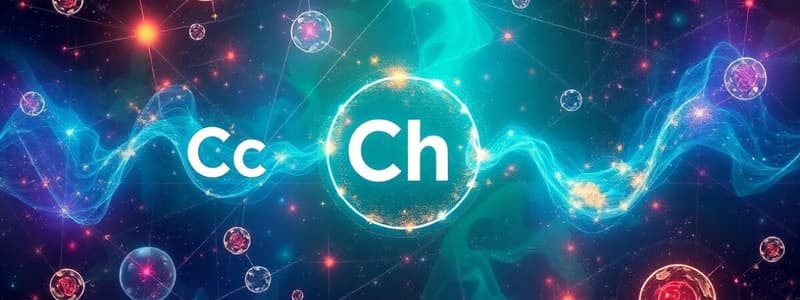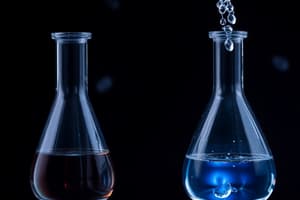Podcast
Questions and Answers
What does the symbol '(aq)' represent in a chemical equation?
What does the symbol '(aq)' represent in a chemical equation?
- A substance in a liquid state
- A substance in a gaseous state
- A substance dissolved in water (correct)
- A solid precipitate
Which of the following best exemplifies the law of conservation of mass?
Which of the following best exemplifies the law of conservation of mass?
- A glass of water evaporates over time
- A balloon inflates when air is added.
- Heating a substance changes its state from solid to liquid.
- When 10g of hydrogen reacts with 80g of oxygen, 90g of water is formed (correct)
Which of the following is a characteristic of a homogeneous mixture?
Which of the following is a characteristic of a homogeneous mixture?
- The substances retain their individual properties.
- Uniform composition throughout. (correct)
- Non-uniform composition throughout.
- Visible layers of different substances.
If a block of wood has a mass of 100g and a volume of 200mL, what is its density?
If a block of wood has a mass of 100g and a volume of 200mL, what is its density?
Which type of chemical reaction involves one substance breaking down into multiple simpler substances?
Which type of chemical reaction involves one substance breaking down into multiple simpler substances?
What is the primary factor that determines the identity of an element?
What is the primary factor that determines the identity of an element?
Which of the following describes valence electrons?
Which of the following describes valence electrons?
Which of the following is an example of a chemical property?
Which of the following is an example of a chemical property?
What happens to atoms when elements form chemical compounds?
What happens to atoms when elements form chemical compounds?
Which state of matter has particles that are close together but can move past each other?
Which state of matter has particles that are close together but can move past each other?
What is the term for substances that enter into a chemical reaction?
What is the term for substances that enter into a chemical reaction?
What does the subscript '2' in the chemical formula H₂O indicate?
What does the subscript '2' in the chemical formula H₂O indicate?
Which of the following is a characteristic of a solid?
Which of the following is a characteristic of a solid?
Flashcards
What is a chemical equation?
What is a chemical equation?
A representation of a chemical reaction using the symbols of elements and compounds, with arrows indicating the direction of the reaction.
What is a decomposition reaction?
What is a decomposition reaction?
A type of chemical reaction where a single reactant breaks down into two or more products.
What is a solution?
What is a solution?
A homogeneous mixture where one substance (solute) dissolves in another (solvent).
What is density?
What is density?
Signup and view all the flashcards
What is balancing chemical equations?
What is balancing chemical equations?
Signup and view all the flashcards
Atom
Atom
Signup and view all the flashcards
Element
Element
Signup and view all the flashcards
Proton
Proton
Signup and view all the flashcards
Neutron
Neutron
Signup and view all the flashcards
Electron
Electron
Signup and view all the flashcards
Compound
Compound
Signup and view all the flashcards
Chemical Formula
Chemical Formula
Signup and view all the flashcards
Valence Electrons
Valence Electrons
Signup and view all the flashcards
Study Notes
-
Matter: Everything that has mass and takes up space. Examples include solids, liquids, and gases.
-
Elements: Substances that cannot be broken down into simpler substances by chemical means. Organized on the periodic table.
-
Atoms: The basic building blocks of matter. Composed of protons, neutrons, and electrons.
-
Protons: Positively charged particles found in the nucleus of an atom.
-
Neutrons: Neutral particles found in the nucleus of an atom.
-
Electrons: Negatively charged particles that orbit the nucleus of an atom.
-
Compounds: Substances formed when two or more elements combine chemically in a fixed ratio. Examples include water (H₂O) and carbon dioxide (CO₂).
-
Chemical formulas: Represent the composition of a compound using symbols for elements and subscripts to indicate the number of atoms of each element.
-
Molecules: Groups of two or more atoms held together by chemical bonds. Can be formed by elements or compounds.
-
Periodic Table: A table organizing elements based on their atomic structure and properties.
Atomic Structure and Arrangement
- Electron shells (or energy levels): Electrons orbit the nucleus in specific energy levels, further from the nucleus meaning higher energy.
- Valence electrons: Electrons in the outermost energy level; these are critical in chemical bonding.
- Atomic number: The number of protons in an atom's nucleus. This number determines which element it is.
- Atomic mass (or atomic weight): The average mass of an atom of an element, taking into account the isotopes.
Properties of Matter
- Physical properties: Characteristics that can be observed or measured without changing the substance's identity. Examples include color, density, melting point, and boiling point.
- Chemical properties: Characteristics that describe how a substance reacts with other substances to form new substances. Examples include flammability, reactivity with acids, and tendency to rust.
- States of matter: Solids, liquids, and gases. They differ in the arrangement and movement of particles.
- Solids: Particles tightly packed, fixed positions, and vibrate in place.
- Liquids: Particles close together, but can move past each other. Have a definite volume, but not a definite shape.
- Gases: Particles widely spaced, move freely and rapidly in all directions. Have no definite volume or shape.
Chemical Reactions
- Reactants: Substances that enter into a chemical reaction.
- Products: Substances formed as a result of a chemical reaction.
- Chemical equation: A representation of a chemical reaction using chemical formulas and symbols. Examples of symbols include +, →, (s), (l), (g), (aq).
- Conservation of mass: In any chemical reaction, the total mass of the reactants equals the total mass of the products.
- Types of chemical reactions: Multiple types exist, including synthesis (combination), decomposition, single replacement, double replacement, combustion, neutralization.
- Balancing chemical equations: Adjusting the coefficients in a chemical equation to ensure the number of atoms of each element is equal on both sides of the equation.
Measurement
- Mass: A measure of the amount of matter in an object. Measured in grams (g).
- Volume: The amount of space an object occupies. Measured in liters (L) or milliliters (mL).
- Density: A measure of how much mass is packed into a given volume. Density = Mass/Volume.
Mixtures and Solutions
- Mixtures: Formed by combining two or more substances without a chemical reaction. The substances retain their individual properties.
- Solutions: A type of homogeneous mixture where one substance (solute) dissolves in another (solvent).
- Homogeneous mixtures: Mixtures with a uniform composition throughout. All parts look the same.
- Heterogeneous mixtures: Mixtures with a non-uniform composition. Different parts are visible. Example: sand in water.
Studying That Suits You
Use AI to generate personalized quizzes and flashcards to suit your learning preferences.




